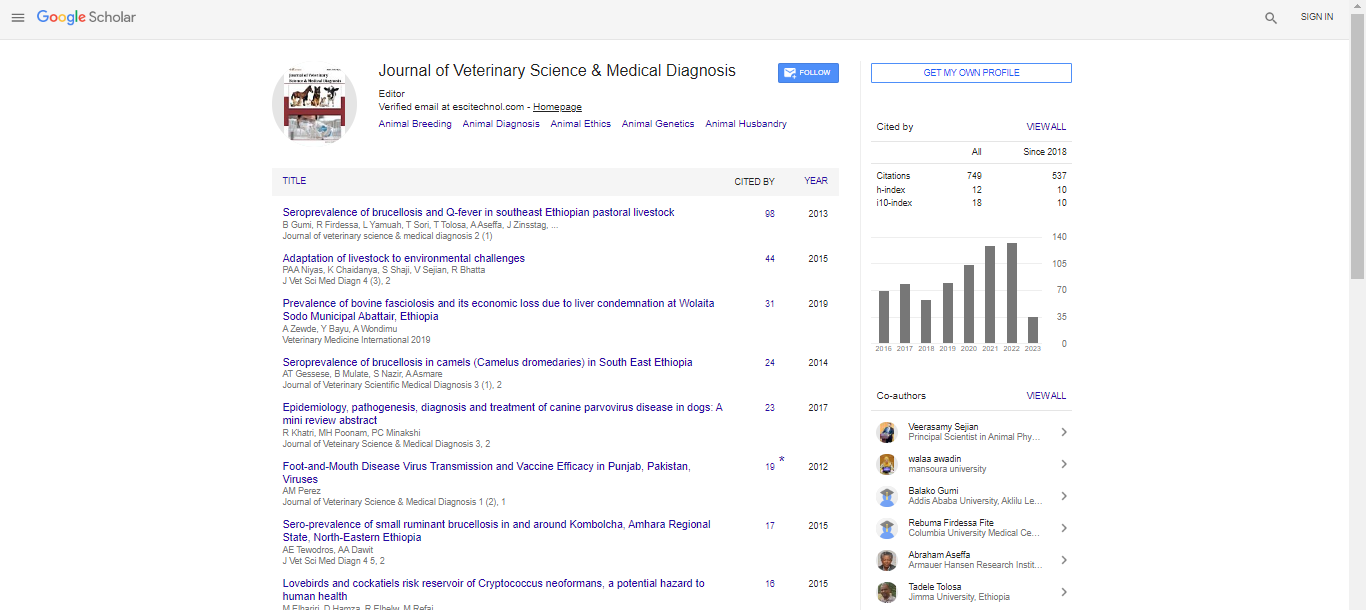Short Communication, J Vet Sci Med Diagn Vol: 12 Issue: 3
Formulation Strategies and Therapeutic Efficacy in Veterinary Drug Delivery
Damer Blake*
1Department of Pathobiology, The Royal Veterinary College, University of London, London, UK
*Corresponding Author: Damer Blake,
Department of Pathobiology, The Royal
Veterinary College, University of London, London, UK
E-mail: blake@dmr.uk
Received: 23 August, 2023, Manuscript No. JVSMD-23-117652;
Editor assigned: 28 August, 2023, PreQC No. JVSMD-23-117652 (PQ);
Reviewed: 11 September, 2023, QC No. JVSMD-23-117652;
Revised: 18 September, 2023, Manuscript No. JVSMD-23-117652 (R);
Published: 25 September, 2023 DOI: 10.35248/2325-9590.23.12.1000066
Citation: Blake D (2023) Formulation Strategies and Therapeutic Efficacy in Veterinary Drug Delivery. J Vet Sci Med Diagn 12:5.
Description
The field of veterinary medicine has witnessed remarkable advancements in recent years, particularly in drug delivery techniques. These innovations have not only enhanced the efficacy of treatments but also improved the overall welfare of animals. From developing novel drug formulations to employing drug delivery systems, the evolution of veterinary drug delivery methods has revolutionized the way to care for animal companions. Traditionally, drugs administered to animals were limited to oral medications, injections, or topical applications. However, recent breakthroughs have expanded the options available to veterinarians and pet owners. One of the notable advancement is development of palatable formulations, such as flavored tablets and chewable treats, making it easier to administer medications to pets. These formulations improve compliance, ensuring that animals receive the full course of treatment without the stress of forceful administration. Furthermore, advancements in nanotechnology have led to the creation of nano-sized drug carriers. Nanoformulations enhance drug solubility, stability, and bioavailability. These carriers can encapsulate a variety of drugs, allowing for targeted delivery to specific cells or tissues. In veterinary oncology, for instance, nanocarriers have enabled precise delivery of chemotherapeutic agents, minimizing side effects and improving the quality of life for pets undergoing cancer treatments [1,2].
Transdermal patches have also gained prominence in veterinary medicine. These patches provide a non-invasive method of drug delivery through the skin, allowing for controlled release over an extended period. Transdermal patches are particularly useful for animals that are difficult to medicate orally or those with chronic conditions requiring continuous drug administration. This innovation ensures consistent drug levels in the bloodstream, optimizing therapeutic outcomes. Advancements in targeted drug delivery systems have revolutionized veterinary treatments. Antibody-Drug Conjugates (ADCs) are one such innovation, combining the specificity of antibodies with the potency of cytotoxic drugs. In veterinary oncology, ADCs can selectively target cancer cells, delivering a powerful therapeutic payload directly to the site of the disease. This approach minimizes damage to healthy tissues, reducing side effects and improving the overall safety profile of treatments [3-6].
Another breakthrough is the use of implantable drug delivery devices. These devices can be surgically implanted beneath the skin and programmed to release medications at predetermined intervals. Implants provide a sustained release of drugs, ensuring a constant therapeutic effect without the need for frequent administrations. This technology is particularly beneficial for managing chronic conditions, such as diabetes or pain, in companion animals. Advancements in veterinary drug delivery have also paved the way for personalized medicine in animal healthcare. Genetic and metabolic differences among animals can influence drug responses. Pharmacogenomic studies have elucidated these variations, allowing veterinarians to do treatments based on an individual animal's genetic makeup. Personalized medicine ensures that the right drug, at the right dose, and in the right form, is administered to achieve the best therapeutic outcome while minimizing adverse effects [7-9].
The impact of advancements in veterinary drug delivery extends beyond companion animals to livestock and wildlife conservation efforts. In agriculture, controlled-release formulations and implantable devices have streamlined the administration of growth-promoting hormones and vaccines in livestock, enhancing farm productivity and animal welfare simultaneously. In wildlife conservation, novel drug delivery methods have played an essential role in the management of endangered species. Remote delivery systems, such as dart guns equipped with drug-filled syringes, enable veterinarians and conservationists to administer medications to wildlife from a safe distance. This approach minimizes stress to the animals and reduces the risk of human-wildlife conflict, fostering successful conservation initiatives [10].
References
- Magnusson BM, Walters KA, Roberts MS (2001) Veterinary drug delivery: Potential for skin penetration enhancement. Adv Drug Deliv Rev 50:205-227.
[Google Scholar] [PubMed]
- Winzenburg G, Schmidt C, Fuchs S, Kissel T (2004) Biodegradable polymers and their potential use in parenteral veterinary drug delivery systems. Adv Drug Deliv Rev 56:1453-1466.
- da Silva CF, Almeida T, de Melo Barbosa R, Cardoso JC, Morsink M0 (2021) New trends in drug delivery systems for veterinary applications. Pharm Nanotechnol 9:15-25.
[Crossref] [Google Scholar] [PubMed]
- Rathbone MJ, Gurny R (2000) Controlled release veterinary drug delivery: Biological and pharmaceutical considerations. Elsevier.
- Rathbone MJ, Macmillan KL, Bunt CR, Burggraaf S (1997) Conceptual and commercially available intravaginal veterinary drug delivery systems. Adv Drug Deliv Rev 28:363-392. [Crossref]
- Cardinal JR (1985) Controlled drug delivery: Veterinary applications. J Control Release 2:393-403.
- Baggot JD (1988) Veterinary drug formulations for animal health care: An overview. J Control Release 8:5-13.
- Siepmann J, Siegel RA, Rathbone MJ (2001) Fundamentals and applications of controlled release drug delivery Springer.
- Streppa HK, Singer MJ, Budsberg SC (2001) Applications of local antimicrobial delivery systems in veterinary medicine. J Am Vet Med Assoc 210:40-48.
[Crossref] [Google Scholar] [PubMed]
- Majumdar S, Duvvuri S, Mitra AK (2004) Membrane transporter/receptor-targeted prodrug design: Strategies for human and veterinary drug development. Adv Drug Deliv Rev 56:1437-1452.
[Google Scholar] [PubMed]
 Spanish
Spanish  Chinese
Chinese  Russian
Russian  German
German  French
French  Japanese
Japanese  Portuguese
Portuguese  Hindi
Hindi 
